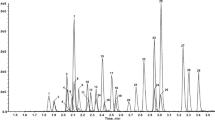Summary
After the examination of more than 300 hair samples of suspected heroin abusers, a large number of which proved positive, we can say that high concentrations of dihydrocodeine can be determined either in addition to, or in the place of, morphine and also frequently in combination with codeine. The opiates were extracted after dissolving the hair samples in NaOH and hydrolysis with HCI. The quantitative determination of dihydrocodeine was achieved by derivatisation with HFBA using GC/MS at m/u = 497. Dihydrocodeine is used in antitussive drugs. After the examination of individual hair samples, it was obvious that some heroin consumers had switched to dihydrocodeine. This may lead to the conclusion that dihydrocodeine itself is used either as an intoxicating drug or to reduce withdrawal symptoms. The increasing number of positive samples should be noted by the legal authorities.
Zusammenfassung
Im ersten Halbjahr 1990 wurde in einer großen Zahl von Haarproben, die wegen des Verdachts auf Heroinkonsum entnommen worden waren und deshalb auf Morphinderivate untersucht wurden, Dihydrocodein in Konzentrationen über 1 gg/g nachgewiesen. Häufig wurde es in Begleitung von Morphin und Codein gefunden, in manchen Fällen aber auch als einziges Morphinderivat. Der Nachweis erfolgt nach Auflösung der Haare in NaOH, Hydrolyse and Extraktion gaschromatographisch-massenspektrometrisch nach Derivatisierung mit Heptafluorbuttersäure. Dihydrocodein wird wie Codein als Antitussivum eingesetzt. Offensichtlich wechseln Heroinkonsumenten in manchen Fällen zu Dihydrocodein oder nehmen beides, so daß man annehmen kann, daß es entweder selbst als berauschendes Mittel oder zur Milderung von Entzugserscheinungen verwendet wird. Die steigende Zahl der Fälle des offensichtlichen Medikamentenmißbrauchs sollte bei den Gesetzgebern zu entsprechenden Konsequenzen führen.
Similar content being viewed by others
References
Klug E (1980) Zur Morphinbestimmung in Kopfhaaren. Z Rechtsmed 84:189–193
Reinhardt G, Sachs H (1986) Codein und das Betdubungsmittelgesetz. In: Heberer G, Opderbecke HW, Spann W (eds) Arztliches Handeln (Festschrift für Walther Weißauer). Springer Verlag, Berlin Heidelberg New York, pp 128–131
Sachs H, Brunner H (1986) Opiatuntersuchungen in Haaren mit GC/MS. Beitr Gerichtl Med 44:281–288
Sachs H, Arnold W (1989) Results of comparative determination of morphine in human hair using RIA and GC/MS. Clin Chem Clin Biochem 27:873–877
Scheller M, Sachs M (1989) Nachweis von Codeinmißbrauch durch Haaranalyse. Dtsch Med Wochenschr 115:1313–1315
Author information
Authors and Affiliations
Rights and permissions
About this article
Cite this article
Sachs, H., Denk, R. & Raff, I. Determination of dihydrocodeine in hair of opiate addicts by GC/MS. Int J Leg Med 105, 247–250 (1993). https://doi.org/10.1007/BF01370380
Received:
Revised:
Issue Date:
DOI: https://doi.org/10.1007/BF01370380




